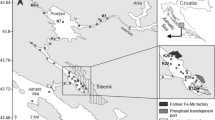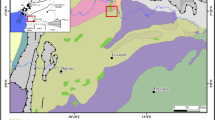Abstract
The extensive extraction activity of mercury ores in Asturias (northwest Spain), also rich in As and Sb, has impacted the Nalón river estuary. The objective of this research was to assess the historical evolution of As-Hg-Sb accumulation in the salt marsh sediments of this area. For this purpose, sediment cores were collected from two different salt marshes (eastern and western river banks) in the estuarine environment to evaluate the degree of anthropogenic enrichment and the geochronology of As-Hg-Sb accumulation. Core subsampling was performed by cutting 2-cm-thick slices of sediments. The subsamples were then analysed for several physical and chemical parameters. Sedimentation rate was assessed by measuring short-lived radionuclides (excess 210Pb and 137Cs). Pre-mining levels of As-Hg-Sb were observed at core depths below 50 cm. In the less extended salt marsh (eastern river bank), maximum As-Hg-Sb concentrations of 87.48, 3.66, and 5.75 μg·g−1, respectively, were found at the core top as a consequence of long-term mining activity in the area. The vertical distribution of As-Hg-Sb was influenced by the single-point contamination sources, whereas grain-size variability and diagenetic remobilisation did not seem affected. Geochronological measurements showed that the depositional fluxes of As-Hg-Sb were influenced by anthropogenic input after 1900, when mining activity in the area was most intense. Hg mining ceased in 1969; however, the corresponding core profiles did not show a drastic decreasing trend in element fluxes, implying that the river drainage basin retains some “memory” of contamination which affects riverine sediments. A preliminary gross estimation of total As-Hg-Sb “trapped” in the Nalón river salt marsh sediments amounted to approximately 18.7, 1.0, and 0.7 t, respectively. These morphological structures suffer erosive processes, thus representing a potential source of these elements associated with sediments; consequently, management conservation and monitoring of salt marshes should be taken into consideration from this environmental point of view.








Similar content being viewed by others
References
Allen JRL (1989) Evolution of salt-marsh cliffs in muddy and sandy systems: a qualitative comparison of British West-Coast estuaries. Earth Surf Process Landf 14(1):85–92
Allen JRL, Rae JE (1988) Vertical salt-marsh accretion since the Roman Period in the Severn Estuary, southwest Britain. Mar Geol 83(1–4):225–235
Andersen TJ (2017) Some practical considerations regarding the application of 210Pb and 137Cs dating to estuarine sediments. In: Applications of paleoenvironmental techniques in estuarine studies. Springer Netherlands, Dordrecht, pp 121–140
Appleby PG, Oldfield F (1983) The assessment of 210Pb data from sites with varying sediment accumulation rates. In: Paleolimnology. Springer Netherlands, Dordrecht, pp 29–35
Audry S, Blanc G, Schäfer J (2005) The impact of sulphide oxidation on dissolved metal (Cd, Zn, Cu, Cr, Co, Ni, U) inputs into the Lot–Garonne fluvial system (France). Appl Geochem 20(5):919–931
Birch GF (2017) Determination of sediment metal background concentrations and enrichment in marine environments—a critical review. Sci Total Environ 580:813–831
Buchman MF (2008) NOAA Screening Quick Reference Tables. Office of Response and Restoration Division, National Oceanic and Atmospheric Administration, Seattle WA, p. 2
Bricker SB (1996) Retention of sediment and metals by Narragansett Bay subtidal and marsh environments: an update. Sci Total Environ 179:27–46
CCME (2001) Canadian sediment quality guidelines for the protection of aquatic life. Canadian Council of Ministers of the Environment, Winnipeg
Cearreta A, Edeso JM, Ugarte FM (1992) Cambios del nivel del mar durante el Cuaternario reciente en el Golfo de Bizkaia. In: The late Quaternary in the Western Pyrenean Region. UPV, Bilbao, pp 57–94
Cearreta A, Leorri ES (2009) El registro geológico de la transformación ambiental de la ría de Bilbao durante el Holoceno y el Antropoceno. Sociedad de ciencias aranzadi zientzi elkartea, San Sebastian
Chen CW, Kao CM, Chen CF, Dong CD (2007) Distribution and accumulation of heavy metals in the sediments of Kaohsiung Harbor, Taiwan. Chemosphere 66(8):1431–1440
Conaway CH, Watson EB, Flanders JR, Flegal AR (2004) Mercury deposition in a tidal marsh of south San Francisco Bay downstream of the historic New Almaden mining district, California. Mar Chem 90(1):175–184
Connor RF, Chmura GL, Beecher CB (2001) Carbon accumulation in Bay of Fundy salt marshes: implications for restoration of reclaimed marshes. Glob Biogeochem Cycles 15(4):943–954
Covelli S, Langone L, Acquavita A, Piani R, Emili A (2012) Historical flux of mercury associated with mining and industrial sources in the Marano and Grado lagoon (northern Adriatic Sea). Estuar Coast Shelf Sci 13:7–19
Covelli S, Fontolan G, Faganeli J, Ogrinc N (2006) Anthropogenic markers in the Holocene stratigraphic sequence of the Gulf of Trieste (northern Adriatic Sea). Mar Geol 230(1):29–51
Cuvilliez A, Lafite R, Deloffre J, Lemoine M, Langlois E, Sakho I (2015) River flow control on intertidal mudflat sedimentation in the mouth of a macrotidal estuary. Geomorphology 239:174–181
De Cort M, Dubois G, Fridman SD, Germenchuk MG, Izrael YA, Janssens A, Jones AR, Kelly GN, Kvasnikova EV, Matveenko II, Nazarov IM, Pokumeiko YM, Sitak VA, Stukin ED, Tabachny LY, Tsaturov YS, Avdyushin SI (1998) Atlas of Caesium Deposition on Europe after the Chernobyl Accident. Office for Official Publications of the European Communities, Luxembourg
Duarte B, Vaz N, Valentim JM, Dias JM, Silva H, Marques JC, Sleimi N, Caçador I (2017) Revisiting the outwelling hypothesis: modelling salt marsh detrital metal exports under extreme climatic events. Mar Chem 191:24–33
Flor G, Ceñal RC, González MS, Ortega MI (1998) Aspectos morfológicos, dinámicos y sedimentológicos del estuario del Nalón (Asturias, noroeste de España). Trab Geol 20(20):3–39
Flor-Blanco G, Pando L, Morales JA, Flor G (2015) Evolution of beach–dune fields systems following the construction of jetties in estuarine mouths (Cantabrian coast, NW Spain). Environ Earth Sci 73(3):1317–1330
Gallego JLR, Ortiz JE, Sierra C, Torres T, Llamas JF (2013) Multivariate study of trace element distribution in the geological record of Roñanzas Peat Bog (Asturias, N. Spain). Paleoenvironmental evolution and human activities over the last 8000calyr BP. Sci Total Environ 454:16–29
García-Ordiales E, Loredo J, Esbrí JM, Lominchar MA, Millán R, Higueras P (2014) Stream bottom sediments as a mean to assess metal contamination in the historic mining district of Almadén (Spain). Int J Min Reclam Environ 28(6):357–376
Garcia-Ordiales E, Loredo J, Cienfuego P, Covelli S, Flor-Blanco G, Fontolan G, Roqueñí N, Ordoñez A, Flor G (2015) Metales pesados y metaloides en sedimentos de las Marismas del Estuario del río Nalón (Norte de España). Comunicaçõe Geológicas 102:69–72
Fontolan G, Pillon S, Bezzi A, Villalta R, Lipizer M, Triches A, D’Aietti A (2012) Human impact and the historical transformation of saltmarshes in the Marano and Grado Lagoon, northern Adriatic Sea. Estuar Coast Shelf Sci 113:41–56
Hammarstrom JM, Seal RR, Meier AL, Kornfeld JM (2005) Secondary sulfate minerals associated with acid drainage in the eastern US: recycling of metals and acidity in surficial environments. Chem Geol 215(1):407–431
Hasan AB, Kabir S, Reza AS, Zaman MN, Ahsan A, Rashid M (2013) Enrichment factor and geo-accumulation index of trace metals in sediments of the ship breaking area of Sitakund Upazilla (Bhatiary–Kumira), Chittagong, Bangladesh. J Geochem Explor 125:130–137
Heiri O, Lotter AF, Lemcke G (2001) Loss on ignition as a method for estimating organic and carbonate content in sediments: reproducibility and comparability of results. J Paleolimnol 25(1):101–110
Idaszkin YL, del Pilar Alvarez M, Carol E (2017) Geochemical processes controlling the distribution and concentration of metals in soils from a Patagonian (Argentina) salt marsh affected by mining residues. Sci Total Environ 596:230–235
IGME (2012) Geochemical atlas of Spain (Atlas Geoquímico de España). Instituto Geológico y Minero de España, Madrid In Spanish
Julivert, M., Fontbote, J. M., Ribeiro, A., Conde, L. (1972). Mapa tectónica de la Península Ibérica y Baleares 1∶ 1′000 000. Inst. Geol. Min. Esp. Madrid
Larsonneur C (1975) Tidal deposits, Mont Saint-Michel Bay, France. In: Tidal deposits. Springer Berlin, Heidelberg, pp 21–30
Luque C (1985) Las mineralizaciones de mercurio de la Cordillera Cantábrica. PhD Thesis, University of Oviedo, Spain In spanish
Luque C, Gutiérrez Claverol M (2006) La minería del mercurio en Asturias. Rasgos históricos. Ed. Eujoa, Mieres, España, In Spanish, p 560
Mahu E, Nyarko E, Hulme S, Swarzenski P, Asiedu DK, Coale KH (2016) Geochronology and historical deposition of trace metals in three tropical estuaries in the Gulf of Guinea. Estuar Coast Shelf Sci 177:31–40
Mantecón VR, Uceda AC (1992) Análisis histórico de la evolución superficial de los estuarios del País Vasco. Lurralde: Investigación y espacio 15:199–227
Moore DM, Reynolds RC (1989) X-ray diffraction and the identification and analysis of clay minerals, vol 378. Oxford university press, Oxford, p 155
Moreno T, Higueras P, Jones T, McDonald I, Gibbons W (2005) Size fractionation in mercury-bearing airborne particles (HgPM 10) at Almadén, Spain: implications for inhalation hazards around old mines. Atmos Environ 39(34):6409–6419
Müller G (1969) Index of geoaccumulation in sediments of the Rhine River. GeoJournal 2:108–118
Müller G (1981) Die Schwermetallbelastung der Sedimenten des Neckars und Seiner Nebenflu¨sse. Chemiker-Zeitung 6:157–164
Ordóñez A, Álvarez R, Loredo J (2013) Asturian mercury mining district (Spain) and the environment: a review. Environ Sci Pollut Res 20(11):7490–7508
Pasternack GB, Brown KJ (2006) Natural and anthropogenic geochemical signatures of floodplain and deltaic sedimentary strata, Sacramento–San Joaquin Delta, California, USA. Environ Pollut 141(2):295–309
Petranich E, Acquavita A, Covelli S, Emili A (2017) Potential bioaccumulation of trace metals in halophytes from salt marshes of a northern Adriatic coastal lagoon. J Soils Sediments 17:1986–1998
Ritchie JC, McHenry JR (1990) Application of radioactive fallout cesium-137 for measuring soil erosion and sediment accumulation rates and patterns: a review. J Environ Qual 19(2):215–233
Roner M, D'Alpaos A, Ghinassi M, Marani M, Silvestri S, Franceschinis E, Realdon N (2016) Spatial variation of salt-marsh organic and inorganic deposition and organic carbon accumulation: inferences from the Venice lagoon, Italy. Adv Water Resour 93:276–287
Sahu BK (1964) Depositional mechanisms from the size analysis of clastic sediments. J Sediment Res 34(1):73–83
Salminen R, Batista MJ, Bidovec M, Demetriades A, De Vivo B, De Vos W, Duris M, Gilucis A, Gregorauskiene V, Halamic J, Heitzmann P, Lima A, Jordan G, Klaver G, Klein P, Lis J, Locutura J, Marsina K, Mazreku A, O'Connor PJ, Olsson S, Ottesen RT, Petersell V, Plant JA, Reeder S, Salpeteur I, Sandström H, Siewers U, Steenfeldt A, Tarvainen T (eds) (2005) FOREGS geochemical atlas of Europe, part 1—background information, methodology and maps. geological survey of Finland, Espoo
Sanchez-Cabeza JA, Ruiz-Fernández AC, Ontiveros-Cuadras JF, Bernal LHP, Olid C (2014) Monte Carlo uncertainty calculation of 210 Pb chronologies and accumulation rates of sediments and peat bogs. Quat Geochronol 23:80–93
Shotyk W (2002) The chronology of anthropogenic, atmospheric Pb deposition recorded by peat cores in three minerogenic peat deposits from Switzerland. Sci Total Environ 292(1):19–31
Verney R, Lafite R, Brun-Cottan J-P, Le Hir P (2011) Behaviour of a floc population during a tidal cycle: laboratory experiments and numerical modeling. Cont Shelf Res 31(10):S64–S83
Funding
This study was co-supported by the Spanish Ministry of Economy, Industry and Competitiveness through the Research Project METRAMER [grant number MINECO-13-CGL2013-44980-R] and the Asturias Ministry of Education and Science [grant number FC-15-GRUPIN14–067]. The authors are sincerely grateful to two anonymous reviewers for their help in improving an early version of the manuscript. Karry Close is warmly acknowledged for proofreading the final version of the manuscript.
Author information
Authors and Affiliations
Corresponding author
Additional information
Responsible editor: Severine Le Faucheur
Rights and permissions
About this article
Cite this article
Garcia-Ordiales, E., Cienfuegos, P., Roqueñí, N. et al. Historical accumulation of potentially toxic trace elements resulting from mining activities in estuarine salt marshes sediments of the Asturias coastline (northern Spain). Environ Sci Pollut Res 26, 3115–3128 (2019). https://doi.org/10.1007/s11356-017-0449-5
Received:
Accepted:
Published:
Issue Date:
DOI: https://doi.org/10.1007/s11356-017-0449-5




